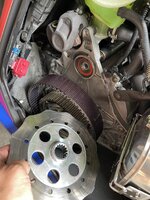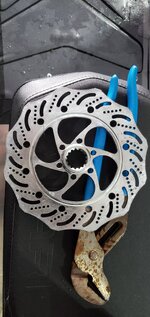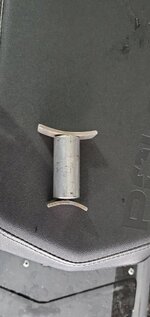Install the app
How to install the app on iOS
Follow along with the video below to see how to install our site as a web app on your home screen.
Note: This feature may not be available in some browsers.
Brake Rotor Removal tips??
- Thread starter mrooks17
- Start date
You are using an out of date browser. It may not display this or other websites correctly.
You should upgrade or use an alternative browser.
You should upgrade or use an alternative browser.
U
It blows tbh. I went in thru a gap between the fuel tank and console with a ratcheting wrench that flexes. Still sucks. Not only that but I noticed no difference with a lighter rotor and lightened bolts on the starter. I knew I wouldn't notice a difference but it wouldn't sting so bad if it was super easy to do.
+1 on the Ratchet wrench. If i remember, you can loosen the Anti-freeze bottle some and will get you some more room. It just seemed time consuming to do not so much hard just tight area. A lot of the light weight stuff is great marketing and can be a PITA to install. However the light rotor should be a factory piece. That boat anchor they have is not needed.
Remove the driven clutch. remove the top and bottom pulleys. remove the bearing on the driven clutch and pull the shaft out. The rotor comes right out install new rotor . I saw this at Jackson Hole .
That bearing is just held in by a retaining ring right? Not pressed?
I've done it this way too. Yes, that bearing is held by a retaining plate, a lot easier to remove than the caliper. If you ever do need to remove the caliper (which you don't in this case), you can reach the bolts from the clutch side with a few carefully assembled extensions.
This.Pulling The gas tank is another quick way to do so.
Easiest access.
X3 on removing jack shaft. Takes 5 minutes. Much easier then anything else IMO.
Thanks everyone. I went the jackshaft route and it was super simple. Couple taps on the jack shaft towards the clutch side and it slid over allowing me to slide the rotor down out of the caliber.
Once this comes back lightened, I should be approaching around 5lbs of rotation weight I have removed from my sled.
Weight reductions:
-Patrick Custom Carbon clutch lightening- 950g
-ZRP Rotor- 450g
-Patrick Custom Carbon Fiber cover and bolts- 280g
-Alt Imp Secondary Spider, Cup, & T30 bolts- 300g
-Alt Imp Primary & Secondary Bolts- 170g
-Alt Imp Clutch weight Pins- 24g
-Alt Imp Starter Bolt & Flywheel nut- ?
This is around 2,200g or 4.8lbs weight reduction. Cost me $1,300 for the above. I've read multiple sources (maybe you guys can give your real world feedback but 1lb rotating mass = 8.4lbs static pound. I don't know if I'll be able to "feel" the performance difference, but I'll find out in a couple months.

Once this comes back lightened, I should be approaching around 5lbs of rotation weight I have removed from my sled.
Weight reductions:
-Patrick Custom Carbon clutch lightening- 950g
-ZRP Rotor- 450g
-Patrick Custom Carbon Fiber cover and bolts- 280g
-Alt Imp Secondary Spider, Cup, & T30 bolts- 300g
-Alt Imp Primary & Secondary Bolts- 170g
-Alt Imp Clutch weight Pins- 24g
-Alt Imp Starter Bolt & Flywheel nut- ?
This is around 2,200g or 4.8lbs weight reduction. Cost me $1,300 for the above. I've read multiple sources (maybe you guys can give your real world feedback but 1lb rotating mass = 8.4lbs static pound. I don't know if I'll be able to "feel" the performance difference, but I'll find out in a couple months.

Last edited:
Depending on how you paid your wallet should easily be 4.8# lighter ?
Its all subtle differences but the more rapid accel /decel of the lighter driverrain definitely makes a sled more precise feeling and aids in confidence getting closer and closer to the egde of it'd abilities
Its all subtle differences but the more rapid accel /decel of the lighter driverrain definitely makes a sled more precise feeling and aids in confidence getting closer and closer to the egde of it'd abilities
It is hard to put a solid number to it like that as the amount of rotating mass to static mass ratio is very dependant on how far the mass is from the center of the axis. Also where that weight loss is positioned on the sled. No doubt it makes a difference though.Thanks everyone. I went the jackshaft route and it was super simple. Couple taps on the jack shaft towards the clutch side and it slid over allowing me to slide the rotor down out of the caliber.
Once this comes back lightened, I should be approaching around 5lbs of rotation weight I have removed from my sled.
Weight reductions:
-Patrick Custom Carbon clutch lightening- 950g
-ZRP Rotor- 450g
-Patrick Custom Carbon Fiber cover and bolts- 280g
-Alt Imp Secondary Spider, Cup, & T30 bolts- 300g
-Alt Imp Primary & Secondary Bolts- 170g
-Alt Imp Clutch weight Pins- 24g
-Alt Imp Starter Bolt & Flywheel nut- ?
This is around 2,200g or 4.8lbs weight reduction. Cost me $1,300 for the above. I've read multiple sources (maybe you guys can give your real world feedback but 1lb rotating mass = 8.4lbs static pound. I don't know if I'll be able to "feel" the performance difference, but I'll find out in a couple months.
The performance differences maybe psychosomatic. I too have chased down the "rotating mass path" many years ago and gave up after many losses to the wallet. It only applies to racing applications where you are only concerned with fractional second improvements and you spend your sponsors money and not your own. For high elevation back country snowmobiling my best ever improvements came from lower gearing, longer track/lugs and aftermarket clutching tuned for high elevation operations. If you have money to blow get aftermarket shocks and an OEM only turbo. The stories I could tell about my aftermarket turbo issues.Thanks everyone. I went the jackshaft route and it was super simple. Couple taps on the jack shaft towards the clutch side and it slid over allowing me to slide the rotor down out of the caliber.
Once this comes back lightened, I should be approaching around 5lbs of rotation weight I have removed from my sled.
Weight reductions:
-Patrick Custom Carbon clutch lightening- 950g
-ZRP Rotor- 450g
-Patrick Custom Carbon Fiber cover and bolts- 280g
-Alt Imp Secondary Spider, Cup, & T30 bolts- 300g
-Alt Imp Primary & Secondary Bolts- 170g
-Alt Imp Clutch weight Pins- 24g
-Alt Imp Starter Bolt & Flywheel nut- ?
This is around 2,200g or 4.8lbs weight reduction. Cost me $1,300 for the above. I've read multiple sources (maybe you guys can give your real world feedback but 1lb rotating mass = 8.4lbs static pound. I don't know if I'll be able to "feel" the performance difference, but I'll find out in a couple months.
Cinno
Depends where the mass is located. The father away from the center the bigger the difference. Crankshaft will make more of a difference than the jackshaft, since under normal mtn riding contains the crank is spinning much faster than the jack shaft. There are a lot that goes into it. Like said, in racing condition when micro seconds count it’ll be more important.
Totally agree here, to put a finer point on it: all the rotating masses in the drivetrain add together to create a loss at the motor drive shaft. The classic formula, force equals mass times acceleration (F= MA) applies. When you have gearboxes between masses the acceleration rate at each component after the gearbox is reduced by the ratio change as is the torque required as seen by the motor to provide that acceleration. So given the secondary has about a 3:1 ratio below shift speed, playing around below 20 mph, if the secondary rotating mass was about the same as primary, the energy to accelerate that mass would be only 1/9 that of the primary. This is because the secondary acceleration rate is 1/3 the primary and the torque required at the primary to accelerate the secondary is also 1/3.Depends where the mass is located. The father away from the center the bigger the difference. Crankshaft will make more of a difference than the jackshaft, since under normal mtn riding contains the crank is spinning much faster than the jack shaft. There are a lot that goes into it. Like said, in racing condition when micro seconds count it’ll be more important.
Same calculations apply to the chaincase so given a 3:1 CVT with a 3:1 chaincase the effects of rotating mass of the lower gear back to the motor shaft is 1/81.
Another interesting thing to point out is once you get the motor to CVT shift speed the motor stops accelerating so the motor mass losses drop to zero. All that money spent on primary clutch mass reduction is wasted although still appreciated as it gives you that zippy feeling. The rest of the minimal drivetrain rotating mass losses remain but increase at a lower rate as dictated by the sled's overall linear acceleration rate which is limited by sled and rider weight. So from 0 to ~20 mph the sled acceleration increases as the up its maximum after that it is rather constant up to max speed.
When Polaris introduced the new axis motor back in circa 2015 it was a game changer, with noticeable seat-of-the-pants reduced inertia. I believe most of that reduction came from the crank and harmonic balancer which as compared to the clutch have much larger inertias.
Cinno
Where does more rotating mass have a positve effect by the inertia or flywheel effect to carry the sled through steeper sections of a climb without losing track speed? I've often thought about this but always came to the conclusion that the lower the mass the better, as those gains are more noticeable.Totally agree here, to put a finer point on it: all the rotating masses in the drivetrain add together to create a loss at the motor drive shaft. The classic formula, force equals mass times acceleration (F= MA) applies. When you have gearboxes between masses the acceleration rate at each component after the gearbox is reduced by the ratio change as is the torque required as seen by the motor to provide that acceleration. So given the secondary has about a 3:1 ratio below shift speed, playing around below 20 mph, if the secondary rotating mass was about the same as primary, the energy to accelerate that mass would be only 1/9 that of the primary. This is because the secondary acceleration rate is 1/3 the primary and the torque required at the primary to accelerate the secondary is also 1/3.
Same calculations apply to the chaincase so given a 3:1 CVT with a 3:1 chaincase the effects of rotating mass of the lower gear back to the motor shaft is 1/81.
Another interesting thing to point out is once you get the motor to CVT shift speed the motor stops accelerating so the motor mass losses drop to zero. All that money spent on primary clutch mass reduction is wasted although still appreciated as it gives you that zippy feeling. The rest of the minimal drivetrain rotating mass losses remain but increase at a lower rate as dictated by the sled's overall linear acceleration rate which is limited by sled and rider weight. So from 0 to ~20 mph the sled acceleration increases as the up its maximum after that it is rather constant up to max speed.
When Polaris introduced the new axis motor back in circa 2015 it was a game changer, with noticeable seat-of-the-pants reduced inertia. I believe most of that reduction came from the crank and harmonic balancer which as compared to the clutch have much larger inertias.
Cinno
M
Flex head socket rachet... harbor freight is good enough.I was going to have my rotor lightened at ZRP. Not much room on getting to the bolts behind the caliber. Any tips of tool modifications?
The sled and rider linear momentum is the dominate factor not rotational momentum. I spent some time in 1997 determining the approximate mass moments of inertia for all the drive train components of a Polaris 1996 XCR 600. Primary, secondary belt, jackshaft, brake rotor, upper gear, lower gear and drive shaft. Did acceleration calculations and determined only a few percent of the motors torque is spent accelerating those masses. I switched my spending habits toward more power, less sled weight, gearing and clutching. As of late, I now go after better handling, getting acclimated to altitude, and simply spending more time on the mountain.Where does more rotating mass have a positve effect by the inertia or flywheel effect to carry the sled through steeper sections of a climb without losing track speed? I've often thought about this but always came to the conclusion that the lower the mass the better, as those gains are more noticeable.
Cinno
Similar threads
K
- Replies
- 22
- Views
- 3K
K
- Replies
- 6
- Views
- 2K
S
- Replies
- 4
- Views
- 1K
FOR SALE
2020 Summit-X 175 For Sale
- Replies
- 4
- Views
- 544





